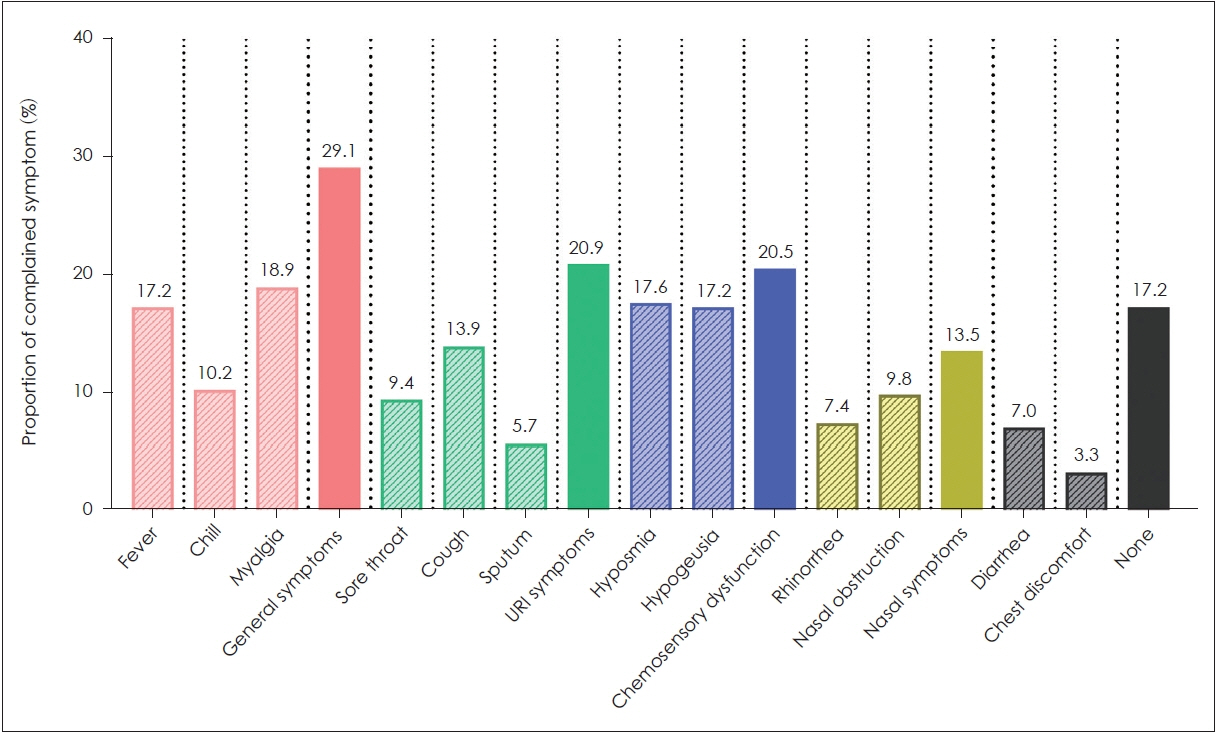J Rhinol.
2021 Mar;28(1):30-35. 10.18787/jr.2020.00336.
Olfactory and Taste Dysfunction in Patients with Asymptomatic and Mildly Symptomatic COVID-19 in Korea
- Affiliations
-
- 1Department of Otolaryngology, Kangwon National University Hospital, Chuncheon, Korea
- 2Department of Otolaryngology, Kangwon National University School of Medicine, Chuncheon, Korea
- 3Department of Internal Medicine, Kangwon National University School of Medicine, Chuncheon, Korea
- 4Department of Neurosurgery, Kangwon National University School of Medicine, Chuncheon, Korea
- KMID: 2513840
- DOI: http://doi.org/10.18787/jr.2020.00336
Abstract
- Background and Objectives
The association between chemosensory dysfunction (CSD) and coronavirus disease 2019 (COVID-19) remains unclear. The aim of the present study was to determine the incidence of olfactory and taste dysfunction in asymptomatic and mildly symptomatic patients with COVID-19 and to evaluate the symptoms associated with CSD in patients with COVID-19. Materials and Method: On March 9, 2020, 309 patients with asymptomatic or mildly symptomatic COVID-19 confirmed by real-time polymerase chain reaction (RT-PCR) were admitted to the No. 7 Community Treatment Center in Korea. An internet-based survey about symptomatology was administered to these patients, with responses obtained from 244 (79.0%). Subjects who completed the survey were enrolled in this study and were categorized into either a CSD group or a normal chemosensory group based on the presence or absence of CSD, respectively.
Results
General symptoms, including fever, myalgia, and chills, were most common (29.1%), followed by upper respiratory tract infection (URI) symptoms (20.9%), CSD (20.5%), and nasal symptoms (13.5%). In patients with CSD (n=50), 10 (4.1%) reported no other symptoms. After adjustment for age, sex, past medical history, and other symptoms, general symptoms [odds ratio (OR), 3.63; confidence interval (CI), 1.70-7.76] and nasal symptoms (OR, 7.00; CI, 2.61-18.80) were significantly associated with CSD.
Conclusion
The incidence of CSD was relatively high (20.5%) in asymptomatic and mildly symptomatic patients with COVID-19. General symptoms were independent risk factors of CSD, suggesting a sensorineural mechanism for the observed olfactory and taste dysfunction.
Figure
Cited by 1 articles
-
The Sniffing Bead System as a Useful Diagnostic Tool for Olfactory Dysfunction in COVID-19
Hyun Jin Min
Korean J Otorhinolaryngol-Head Neck Surg. 2022;65(2):107-111. doi: 10.3342/kjorl-hns.2021.00339.
Reference
-
References
1. Bénézit F, Le Turnier P, Declerck C, Paillé C, Revest M, Dubée V, et al. Utility of hyposmia and hypogeusia for the diagnosis of COVID-19. The Lancet Infectious Diseases. 2020.2. Li YC, Bai WZ, Hashikawa T. The neuroinvasive potential of SARSCoV2 may play a role in the respiratory failure of COVID-19 patients. Journal of Medical Virology. 2020; 92(6):552–5.3. Park PG, Kim CH, Heo Y, Kim TS, Park CW, Kim CH. Out-of-hospital cohort treatment of coronavirus disease 2019 patients with mild symptoms in Korea: an experience from a single community treatment center. J Korean Med Sci. 2020; 35(13):e140.4. Mao L, Jin H, Wang M, Hu Y, Chen S, He Q, et al. Neurologic manifestations of hospitalized patients with coronavirus disease 2019 in Wuhan, China. JAMA Neurol. 2020; 77(6):683–90.5. Vaira LA, Salzano G, Deiana G, De Riu G. Anosmia and ageusia: common findings in COVID-19 patients. Laryngoscope. 2020; 130(7):1787.6. Giacomelli A, Pezzati L, Conti F, Bernacchia D, Siano M, Oreni L, et al. Self-reported olfactory and taste disorders in patients with severe acute respiratory coronavirus 2 infection: a cross-sectional study. Clinical Infectious Diseases. 2020.7. Yan CH, Faraji F, Prajapati DP, Boone CE, DeConde AS. Association of chemosensory dysfunction and COVID-19 in patients presenting with influenza-like symptoms. Int Forum Allergy Rhinol. 2020; 10(7):806–13.8. Netland J, Meyerholz DK, Moore S, Cassell M, Perlman S. Severe acute respiratory syndrome coronavirus infection causes neuronal death in the absence of encephalitis in mice transgenic for human ACE2. Journal of Virology. 2008; 82(15):7264–75.9. Li K, Wohlford-Lenane C, Perlman S, Zhao J, Jewell AK, Reznikov LR, et al. Middle East respiratory syndrome coronavirus causes multiple organ damage and lethal disease in mice transgenic for human dipeptidyl peptidase 4. The Journal of Infectious Diseases. 2016; 213(5):712–22.
- Full Text Links
- Actions
-
Cited
- CITED
-
- Close
- Share
- Similar articles
-
- Contemporary Review of Olfactory Dysfunction in COVID-19
- Comparative Analysis of Olfactory and Gustatory Function of Patients With COVID-19 Olfactory Dysfunction and Non-COVID-19 Postinfectious Olfactory Dysfunction
- Characteristics and Prognosis of COVID-19 Induced Olfactory and Gustatory Dysfunction in Daegu
- A review on photobiomodulation therapy for olfactory dysfunction caused by COVID-19
- The Sniffing Bead System as a Useful Diagnostic Tool for Olfactory Dysfunction in COVID-19


